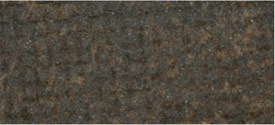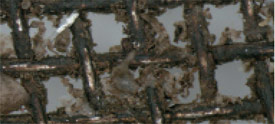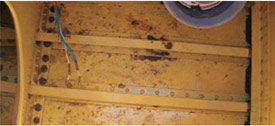
SOURCES OF CONTAMINATION
Contamination can enter the airplane wing from either the uplifted fuel or through the fuel vent systems. Atmospheric dust storms could be contributing to filter contamination; however, Boeing has been unable to correlate engine fuel filter blockage with any airplane pneumatic system problems due to dust storms. If dust storms were contributing to filter contamination, Boeing would expect problems with the airplane bleed system or environmental control system packs.
The individual particulates found on fuel filters are very small, often less than 1 micron in size. However, these particulates become bound together on the filter medium and filter screen. Boeing believes that the sulfates, such as calcium sulfate dihydrate, which are water soluble and polar, are helping to bind these very small particulates together, preventing the material from passing through the filter. Filtration used in fuel uplift vehicles is typically between 0.5 and 1 micron absolute.
Locating the source of engine fuel filter contamination can be very difficult. If an airport is in the process of building or modifying a fuel hydrant system, airlines should ensure that the system is properly flushed before it is put into use. Large quantities of relatively large particulates are an indication that the filtration at an airport is not adequate.
CATEGORIES OF CONTAMINATION
An IATA Technical Fuel Group team is working to standardize the testing procedures for contaminated fuel filters. This procedure will be available from IATA later this year. One of the key efforts in this standardizing testing procedure was to categorize the types of contaminates found on a fuel filter. The IATA team has classified four categories of contaminants:
Category 1: Foreign Objects. This category is for any material found on the filter from a maintenance activity or degradation of the airplane or ground fuel system. Foreign objects include paint chips, paper, aluminum chips, sealant chips, composite materials, and O-rings and gasket materials (see figs. 2 and 3).
CONTAMINATED FUEL FILTER
CAUSES LOSS OF POROSITY
Figure 2
When the engine fuel filter medium becomes clogged with contaminates, it loses its porosity, leading to a fuel filter bypass indication. This filter medium is loaded with silicates and sulfates.
ENGINE FUEL FILTER OUTER
SCREEN AT 30X MAGNIFICATION
Figure 3
This filter screen is contaminated with particulates and a gum residue.
Category 2: Clays and Rust. Clays and dirt comprise very fine particulates that are black, brown, or reddish in color. They are most often associated with dirt in uplifted fuel. Poor filtration processes at airports is the most common source of the dirt. Rust is associated with oxidation of steel piping in either the uplift vehicle or the airport fuel distribution system.
Category 3: Gumlike Residues. This category is for shiny, slimy, jelly-like materials, including microbial contamination and oil and coke deposits (see fig. 4).
MICROBIAL CONTAMINATION
IN A WING TANK
Figure 4
The brown-black debris on the bottom of this tank is made up of fungus and bacteria. Fuel microbial growth can clog fuel filters, causing the airplane fuel quantity indication system to read incorrect values, and eventually cause structural corrosion of the aluminum stringers and wing skin. Operators can greatly reduce the chance of microbial growth by draining water from airplane fuel tanks weekly and by testing for microbes annually.
Category 4: Unknowns. This category includes anything not listed in the first three categories. These materials may require additional laboratory procedures to identify.
Almost every filter examined by Boeing and other laboratories contains the following contaminates:
- Silicates, including clay and dirt with very small particulate sizes.
- Sulfates.
- Salts, primarily sodium chloride and potassium chloride.
- Iron oxides (rust from steel).
- Aluminum chips (due to fuel tank maintenance).
- Tank primer (due to fuel tank maintenance).
- Fibers (from rags left in the tank).
- Trace elements such as magnesium contained in soil.
- Microbial contamination.
- Grease.
- Glycols from cleaning fluids or wing de-icing fluids.
- Polymer from airport water monitors. (This polymer has been found on a number of engine fuel filters, but it is not known whether it has caused any problems with the engine fuel system.)




